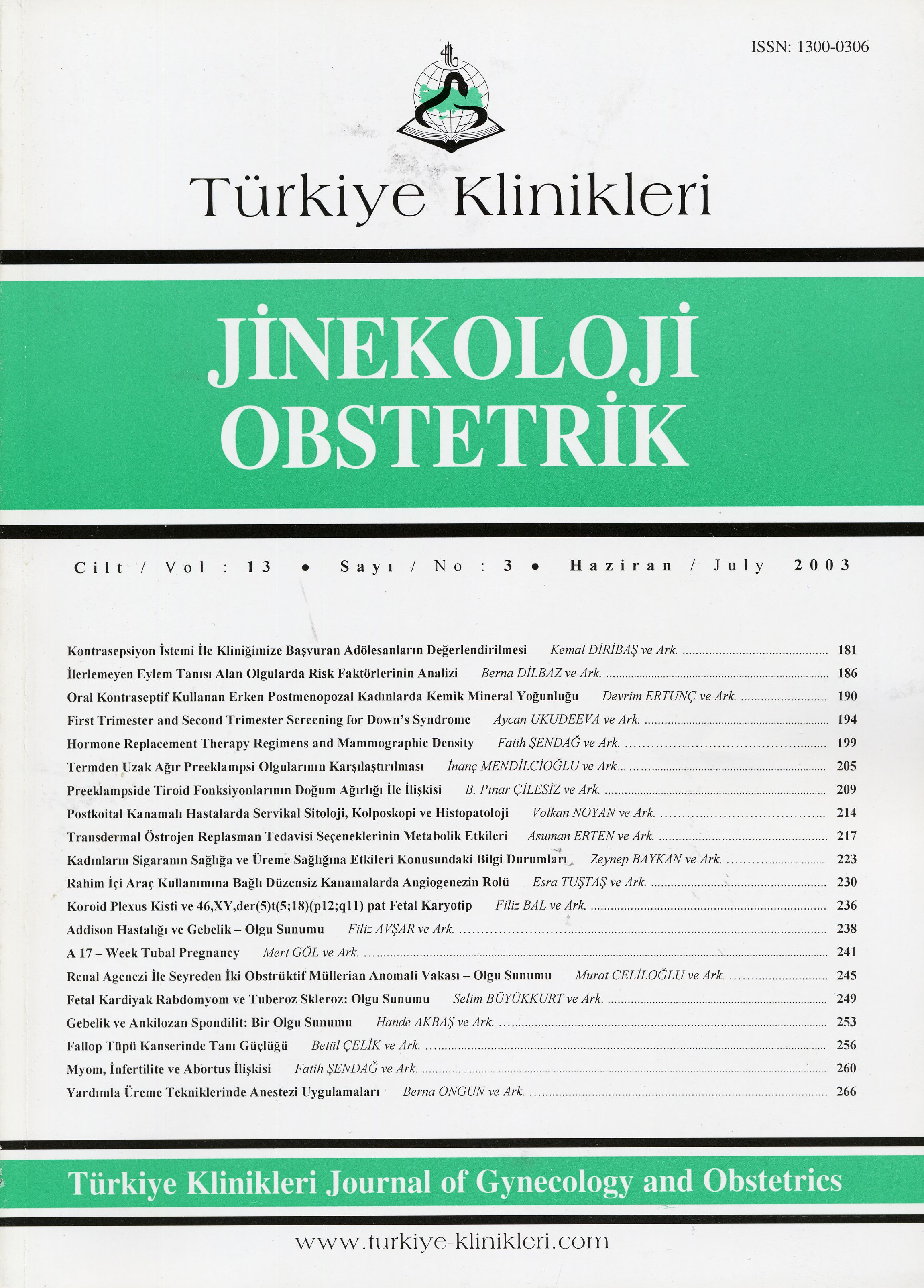Open Access
Peer Reviewed
ARTICLES
5953 Viewed3039 Downloaded
Pregnancy And Ankylosing Spondylitis: A Case Report
Gebelik ve Ankilozan Spondilit: Bir Olgu Sunumu
Turkiye Klinikleri J Gynecol Obst. 2003;13(3):253-5
Article Language: TR
Copyright Ⓒ 2025 by Türkiye Klinikleri. This is an open access article under the CC BY-NC-ND license (http://creativecommons.org/licenses/by-nc-nd/4.0/)
ÖZET
Amaç: Bu olgu sunumunda, 36 yaşında 10 yıldır ankilozan spondiliti (AS) olan gebe bir kadının gebelik seyri ve doğum sırasında ortaya çıkan komplikasyonları ele alındı.Çalışmanın Yapıldığı Yer: İstanbul Üniversitesi Cerrahpaşa Tıp Fakültesi, Kadın Hastalıkları ve Doğum Anabilim Dalı.Bulgular: Hastada ankilozan spondilit bulgularında gebelik süresince alevlenme saptandı. Lumbar omurlardaki hareket kısıtlılığı sebebiyle supin pozisyonda yatamadı. Göğüs duvarının ekspansiyon kapasitesindeki kısıtlılığa travayın da eklenmesiyle solunum kapasitesi giderek azaldı. Bu iki sebeple normal doğum mümkün olamadı. Bu sırada gelişen klinik bulgular plasenta dekolmanını düşündürdü, hasta acil sezaryene alındı. Spinal bölgedeki hareketlilik kaybı ve servikotorasik bölgedeki siddetli kifoz sebebiyle hastada ventilasyon acil trakeostomi ile sağlandı ardından genel anestezi uygulandı. Birinci dakika apgarı 6 olan bebek doğurtuldu.Sonuç: ASli hastaların gebelik sırasında da düzenli takibi devam etmelidir. Doğum ve anestezi şekline doğum eylemi başlamadan evvel karar verilmeli, doğum sırasında gelişebilecek komplikasyonlar açısından klinisyen her an dikkatli olmalıdır.
Amaç: Bu olgu sunumunda, 36 yaşında 10 yıldır ankilozan spondiliti (AS) olan gebe bir kadının gebelik seyri ve doğum sırasında ortaya çıkan komplikasyonları ele alındı.Çalışmanın Yapıldığı Yer: İstanbul Üniversitesi Cerrahpaşa Tıp Fakültesi, Kadın Hastalıkları ve Doğum Anabilim Dalı.Bulgular: Hastada ankilozan spondilit bulgularında gebelik süresince alevlenme saptandı. Lumbar omurlardaki hareket kısıtlılığı sebebiyle supin pozisyonda yatamadı. Göğüs duvarının ekspansiyon kapasitesindeki kısıtlılığa travayın da eklenmesiyle solunum kapasitesi giderek azaldı. Bu iki sebeple normal doğum mümkün olamadı. Bu sırada gelişen klinik bulgular plasenta dekolmanını düşündürdü, hasta acil sezaryene alındı. Spinal bölgedeki hareketlilik kaybı ve servikotorasik bölgedeki siddetli kifoz sebebiyle hastada ventilasyon acil trakeostomi ile sağlandı ardından genel anestezi uygulandı. Birinci dakika apgarı 6 olan bebek doğurtuldu.Sonuç: ASli hastaların gebelik sırasında da düzenli takibi devam etmelidir. Doğum ve anestezi şekline doğum eylemi başlamadan evvel karar verilmeli, doğum sırasında gelişebilecek komplikasyonlar açısından klinisyen her an dikkatli olmalıdır.
ANAHTAR KELİMELER: Ankilozan spondilit, Gebelik, Trakeostomi
ABSTRACT
Objective: In this case report, a 36 years old pregnant woman who had ankylosing spondylitis (AS) for 10 years is presented. Her course of pregnancy and the complications occurring at delivery is reported.Institution: Istanbul University Cerrahpasa Medical School, Obstetrics and Gynecology Department.Results: Our case had aggravated ankylosing spondylitis activity during gestation. Severe limitation of motion of the lumbar spine made it impossible for her to lie down in the supine position. She had frequent contractions of labor, these contractions and restriction of chest wall expansion both decreased her pulmonary capacity. Because of these 2 reasons vaginal delivery seemed not possible. Later on we had the clinical impression of placental abruption and performed emergent cesarean delivery. The patient couldnt be intubated because of the loss of spinal mobility and the severe kyphosis in the cervicothorasic region. Ventilation was maintained by emergency tracheostomy and then she underwent general anaesthesia. Baby with an Apgar score of 6 at 1 minute was delivered. 30% placental separation was noticed.Conclusion: Regular follow up of these patients should continue during pregnancy. The type of delivery and anaesthesia should be decided before the onset of labor, and finally the physician should be aware of the complications that could occur during labor.
Objective: In this case report, a 36 years old pregnant woman who had ankylosing spondylitis (AS) for 10 years is presented. Her course of pregnancy and the complications occurring at delivery is reported.Institution: Istanbul University Cerrahpasa Medical School, Obstetrics and Gynecology Department.Results: Our case had aggravated ankylosing spondylitis activity during gestation. Severe limitation of motion of the lumbar spine made it impossible for her to lie down in the supine position. She had frequent contractions of labor, these contractions and restriction of chest wall expansion both decreased her pulmonary capacity. Because of these 2 reasons vaginal delivery seemed not possible. Later on we had the clinical impression of placental abruption and performed emergent cesarean delivery. The patient couldnt be intubated because of the loss of spinal mobility and the severe kyphosis in the cervicothorasic region. Ventilation was maintained by emergency tracheostomy and then she underwent general anaesthesia. Baby with an Apgar score of 6 at 1 minute was delivered. 30% placental separation was noticed.Conclusion: Regular follow up of these patients should continue during pregnancy. The type of delivery and anaesthesia should be decided before the onset of labor, and finally the physician should be aware of the complications that could occur during labor.
MENU
POPULAR ARTICLES
MOST DOWNLOADED ARTICLES





This journal is licensed under a Creative Commons Attribution-NonCommercial-NoDerivatives 4.0 International License.










